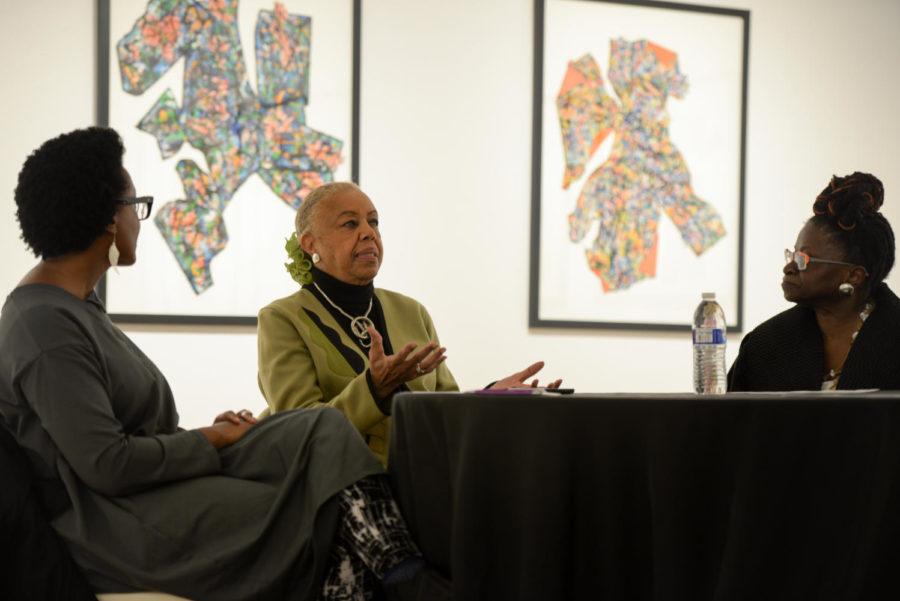Jo-Anne Bates originally went to school to be a printmaker, so most of her first works were in black and white. But after visiting South Africa and seeing all of the colors in the landscape, the clothing and the artwork, she knew she wanted to incorporate them into her own work.
“To be an artist, you have to go beyond what you learned and be your own creative person,” she said.
Bates recounted this realization in front of more than 30 people filling the seats, leaning against the walls and sitting on the floor in the small exhibition room where she spoke at the Pittsburgh Center for the Arts. Her talk was the one of two in-depth conversations hosted by the Center Thursday night as part of their Artists in Conversation event. The first discussion focused on Haylee Ebersole, 2017 Emerging Artist of the Year, and the second on Bates, recognized as the Artist of the Year for her enduring artistic contributions to the Pittsburgh region.
To begin the night, Ebersole spoke with Jessica Beck, the milton fine curator of art at the Andy Warhol Museum. Beck said the first time she saw Ebersole’s work, it gave her a “cosmic, yet organic feeling.”
Ebersole creates her works by making a gelatin mixture herself from large quantities of water, synthetic and organic pigments, and household crystallizing agents. She pours this mixture over assortments of objects including ladders, car bumpers and fences.
The finished products resemble jagged crystallized moon rocks with splashes of color, especially the use of pink, purple and dark blue. The sizes range from as thin as pieces of paper to as tall as a six feet. Smaller works were hung on the walls like traditional artwork, but spectators were able to walk around the bigger pieces.
“The work has endless potential for possibilities for everyday matter,” Ebersole said.
Ebersole said she has been able to create new pieces of work and experiment more through the space provided to her by the Pittsburgh Center of the Arts as part of her prize for being named Emerging Artist of the Year.
“It feels really exciting [being Emerging Artist of the Year], and mostly just to have been able to have so much space to produce large work,” Ebersole said, “and just to feel recognized is really great as an artist, because that doesn’t always happen.”
Audience members Anita Sadler and Scott Grosh sat in the front row at both Ebersole’s and Bates’ exhibition art conversations. Sadler was unaware of the material Ebersole used at first glance and was surprised to discover what her works were really made of.
“I had no idea it was gelatin until she said, I thought the one piece was clay fired in a salt kiln,” Sadler said.
The second exhibition conversation was held with Bates and guest artist Charlotte Ka. Author and art historian Kilolo Luckett mediated the discussion.
One of Bates’ pieces took up the entire room next to the discussion room. Children’s shoes Bates had asked her fellow African-American friends and neighbors for covered the floor. Bates said she wanted her piece to bring the conversation to the young African-American males and females who have been facing police brutality.
Most of Bates’ pieces that were on display were pieces of paper that she dyed, ripped, folded, glued and put through her printmaking process. Splatters of different-colored paint and ink covered them. The topmost layer of the piece included the titles of some of her pieces, including “Cabbage,” “Kale,” “Collards” and “Real Beauty.”
Grosh said seeing all of Bates’ pieces had an impact on him because he was able to see all the individual works together as one body.
“Her pieces really do have a real musical sense about them, and they have a definite rhythm,” Grosh said.
Sadler said she has seen Bates work before, but as she sat in the exhibition and looked at the pieces closely, she saw more and more layers in the objects she hadn’t noticed before.
“Seeing [the pieces] all together in one room, jumping off the walls like that is a very immersive experience,” Sadler said.
During her conversation with Bates, Luckett agreed with Bates’ idea that artists should go beyond what they’re taught and look to the world around them for inspiration. She said she wants her own work to be accessible and for people to embrace it at the same level that classics are placed at someday.
“I think that it’s upon all of us to learn more than what we consume,” Luckett said.


